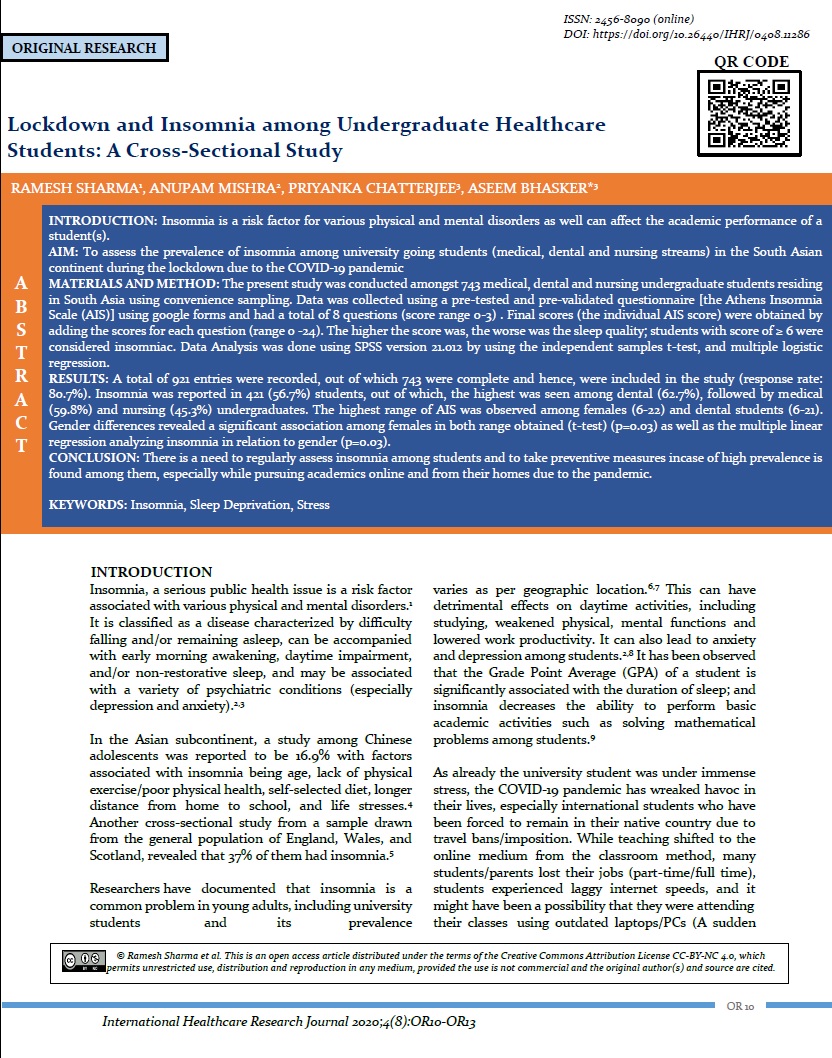Lockdown and Insomnia among Undergraduate Healthcare Students: A Cross-Sectional Study
Abstract
INTRODUCTION: Insomnia is a risk factor for various physical and mental disorders as well can affect the academic performance of a student(s).
AIM: To assess the prevalence of insomnia among university going students (medical, dental and nursing streams) in the South Asian continent during the lockdown due to the COVID-19 pandemic
MATERIALS AND METHOD: The present study was conducted amongst 743 medical, dental and nursing undergraduate students residing in South Asia using convenience sampling. Data was collected using a pre-tested and pre-validated questionnaire [the Athens Insomnia Scale (AIS)] using google forms and had a total of 8 questions (score range 0-3) . Final scores (the individual AIS score) were obtained by adding the scores for each question (range 0 -24). The higher the score was, the worse was the sleep quality; students with score of ≥ 6 were considered insomniac. Data Analysis was done using SPSS version 21.012 by using the independent samples t-test, and multiple logistic regression.
RESULTS: A total of 921 entries were recorded, out of which 743 were complete and hence, were included in the study (response rate: 80.7%). Insomnia was reported in 421 (56.7%) students, out of which, the highest was seen among dental (62.7%), followed by medical (59.8%) and nursing (45.3%) undergraduates. The highest range of AIS was observed among females (6-22) and dental students (6-21). Gender differences revealed a significant association among females in both range obtained (t-test) (p=0.03) as well as the multiple linear regression analyzing insomnia in relation to gender (p=0.03).
CONCLUSION: There is a need to regularly assess insomnia among students and to take preventive measures incase of high prevalence is found among them, especially while pursuing academics online and from their homes due to the pandemic.
Downloads
References
Kaneita Y, Ohida T, Osaki Y, Tanihata T, Minowa M, Suzuki K. Insomnia Among Japanese Adolescents: A Nationwide Representative Survey. Sleep 2006;29(12):1543-50.
X.-l Jiang, X.-y. Zheng, J. Yang, C.-p. Ye, Y.-y. Chen, et al. A systematic review of studies on the prevalence of Insomnia in university students. Public Health 2015; 129(12):1-6. https://doi.org/10.1016/j.puhe.2015.07.030.
Taylor DJ, Lichstein KL, Durrence HH. Insomnia as a health risk factor. Behav Sleep Med. 2003;1:227–247.
Liu X, Uchiyama M, Okawa M, Kurita H. Prevalence and correlates of self-reported sleep problems among Chinese adolescents. Sleep 2000;23:27-34.
Stewart R, Besset A, Bebbington P, et al. Insomnia comorbidity and impact and hypnotic use by age group in a national survey population aged 16 to 74 years. Sleep. 2006;29:1391–1397
Ohayon MM. Epidemiology of insomnia: what we know and what we still need to learn. Sleep Med Rev 2002;6(2):97e111.
Samaranayake CB, Arroll B, Fernando AR. Sleep disorders, depression, anxiety and satisfaction with life among young adults: a survey of university students in Auckland, New Zealand. N. Z Med J. 2014;127(1399):13e22.
Sarsour K, Van Brunt DL, Johnston JA, Foley KA, Morin CM, Walsh JK. Associations of nonrestorative sleep with insomnia, depression, and daytime function. Sleep Med 2010;11(10):965e72.
Kelly WE, Kelly KE, Clanton RC. The relationship between sleep length and grade-point average among college students. Coll Stud J. 2001;35:84–6.
Soldatos CR, Dikeos DG, Paparrigopoulos TJ. Athens insomnia scale: validation of an instrument based on ICD-10 criteria. Journal of Psychosomatic Research 2000;48 (6):555–60.
Dean AG, Sullivan KM, Soe MM. OpenEpi: Open Source Epidemiologic Statistics for Public Health, Version. www.OpenEpi.com, updated 2013/04/06, accessed 2020/04/17.
IBM Corp. Released 2012. IBM SPSS Statistics for Windows, Version 21.0. Armonk, NY: IBM Corp.
Shakeel HA, Maqsood H, Ishaq A, Ali B, Hussain H, Khan AR, et al. Insomnia among medical students: a cross-sectional study. Int J Res Med Sci. 2019 Mar;7(3):893-8. http://dx.doi.org/10.18203/2320-6012.ijrms20190944
Atkinson G, Davenne D. Relationship between sleep, physical activity and human health. Physiol Behav. 2007;90(2-3):229-35.
Sing CY, Wong WS. Prevalence of Insomnia and Its Psychosocial Correlates Among College Students in Hong Kong, Journal of American College Health 2010;59(3):174-82. http://dx.doi.org/10.1080/07448481.2010.497829
Voelker R. Stress, sleep loss, and substance abuse create potent recipe for college depression. J Am Med Assoc. 2004;291(18):2177e9.
Johnson EO, Roth T, Schultz L, Breslau N. Epidemiology of DSM-IV insomnia in adolescence: lifetime prevalence, chronicity, and an emergent gender difference. Pediatrics 2006;17(2):e247e56.
Pallos H, Gergely V, Yamada N, Miyazaki S, Okawa M. The quality of sleep and factors associated with poor sleep in Japanese graduate students. Sleep Biol Rhythms 2007;5:234e8
Wong JG, Patil NG, Beh SL, Cheung EP, Wong V, Chan LC, et al. Cultivating psychological well-being in Hong Kong’s future doctors. Med Teach. 2005;27:715-9.
Foley DJ, Monjan AA, Brown SL, Simonsick EM, Wallace RB, Blazer DG. Sleep complaints among elderly persons: an epidemiologic study of three communities. Sleep. 1995;18(6):425-32.

Copyright (c) 2020 Ramesh Sharma et al.

This work is licensed under a Creative Commons Attribution-NonCommercial 4.0 International License.


